World Journal of Cardiovascular Diseases
Vol.3 No.3(2013), Article ID:32513,5 pages DOI:10.4236/wjcd.2013.33041
Retrograde percutaneous coronary intervention via critically degenerated saphenous vein grafts for chronic total occlusion in native coronary arteries
![]()
1Department of Cardiology, Fukaya Red-Cross Hospital, Saitama, Japan
2Department of Medicine and Biological Science, Graduate School of Medicine, Gunma University, Gunma, Japan
Email: makoto-s@qj8.so-net.ne.jp
Copyright © 2013 Makoto Sekiguchi et al. This is an open access article distributed under the Creative Commons Attribution License, which permits unrestricted use, distribution, and reproduction in any medium, provided the original work is properly cited.
Received 5 March 2013; revised 11 April 2013; accepted 20 May 2013
Keywords: Percutaneous Coronary Intervention; Total Occlusion; Saphenous Vein Grafts
ABSTRACT
We report the case of a 78-year-old woman with saphenous vein graft (SVG) disease and chronic total occlusion (CTO) in three native coronary arteries [left anterior descending artery (LAD), left circumflex artery, and the right coronary artery], who was successfully treated by percutaneous coronary intervention (PCI) using the retrograde approach via the critically degenerated SVGs. The patient, a 78-yearold woman, presented with sudden chest pain and dyspnea. She had previously undergone coronary artery bypass surgery using SVGs for the three vessels and percutaneous coronary intervention with sirolimus-eluting stent placement in the posterolateral branch 13 and 3 years ago, respectively. Electrocardiography revealed ST-segment elevation in leads V1-4, whereas emergent coronary angiography revealed total occlusion in her native coronary arteries. Primary PCI was scheduled. A channel dilator was advanced very smoothly and safely into the distal site of the CTO lesion in the LAD, which showed complete occlusion in the proximal region, via an SVG that was temporally occluded four days earlier. A reverse controlled antegrade and retrograde tracking technique was used to successfully perform percutaneous recanalization. Subsequently, the other two native CTO lesions protected by critically degenerated SVGs were treated with retrograde intervention via the SVGs. The retrograde approach via critically degenerated SVGs is safe, reliable, and fast. If an SVG bypassing the native CTO lesion is critically degenerated, percutaneous coronary intervention should be performed via the SVG.
1. INTRODUCTION
Despite the use of drug-eluting stents, saphenous vein graft (SVG) disease accounts for a subset of all percutaneous coronary interventions (PCIs) that are not successful because of inadequate dilatation, a high risk of distal embolism, and a low rate of long-term patency [1]. Therefore, PCI for native arteries should be considered in all possible cases. The outcome of PCI with drug-eluting stent placement in the native coronary arteries has been established. However, in case of chronic total occlusion (CTO), it is sometimes difficult to achieve an initial successful recanalization by PCI.
PCI using the retrograde approach has recently become a widely used alternative method for recanalization of arteries with CTO [2-4]. In particular, the development of the Corsair microcatheter (Asahi Intecc Co. Ltd., Aichi, Japan) as a collateral channel dilator has made the retrograde approach a safe and reliable method [5,6].
We report the case of a 78-year-old woman with SVG disease and CTO in three native coronary arteries, who was successfully treated by PCI using the retrograde approach via the critically degenerated SVGs.
2. CASE
A 78-year-old female presenting with sudden chest pain and dyspnea was transferred from a local hospital to the Department of Cardiology at Fukaya Red-Cross Hospital. Her coronary risk factors were hypertension, hyperlipidemia and obesity (BMI 32.8). Her medical history included a coronary artery bypass graft (CABG) surgery using only SVGs for three vessels 13 years back, and PCI with sirolimus-eluting stent placement via the degenerated SVG of the posterolateral (PL) branch 3 years back. Her electrocardiogram showed ST-segment elevation in leads V1-4. An emergent coronary angiogram revealed total occlusions at the ostium of the left anterior descending artery (LAD), the proximal portion of the left circumflex artery (LCX), and the proximal portion of the right coronary artery (RCA). The SVG-LAD was also totally occluded at the proximal portion. The SVG-PL and SVG-right posterior descending artery had several tight stenoses (Figure 1). We decided to perform primary PCI for the SVG-LAD, which was thought to have an infarct-related lesion. A 7 Fr Amplatz-Left (AL) 1.0 guiding catheter (Heartrail II, Terumo Corp., Tokyo, Japan) was inserted into the ostium of the SVG-LAD through the right femoral artery. The first attempt with a Runthrough NS guidewire and a Navicath microcatheter (Terumo Corp.) failed. Therefore, the guidewire was changed to a Miracle 3 g (Asahi Intecc Co. Ltd.). With the guidewire and microcatheter advancing alternately, the Miracle 3 g guidewire was advanced into the distal LAD. Continuously, multiple sequential dilations were performed using 2.0-mm and 3.0-mm diameter balloons. Angiography revealed suboptimal flow with multiple associated thrombi located along the long portion of the SVG body (Figure 2(A)). An Eliminate aspiration catheter (Terumo Corp.) was used for thrombus aspiration. Angiography performed after thrombectomy revealed optimal flow to the distal LAD (Figure 2(B)). However, many thrombi and degenerated plaque remained in the long body of the SVG-LAD, indicating that the SVGLAD could be occluded almost immediately after surgery. However, we decided to conclude primary PCI at that point because subsequent stent deployment had a great risk of critical distal embolism, and we decided to
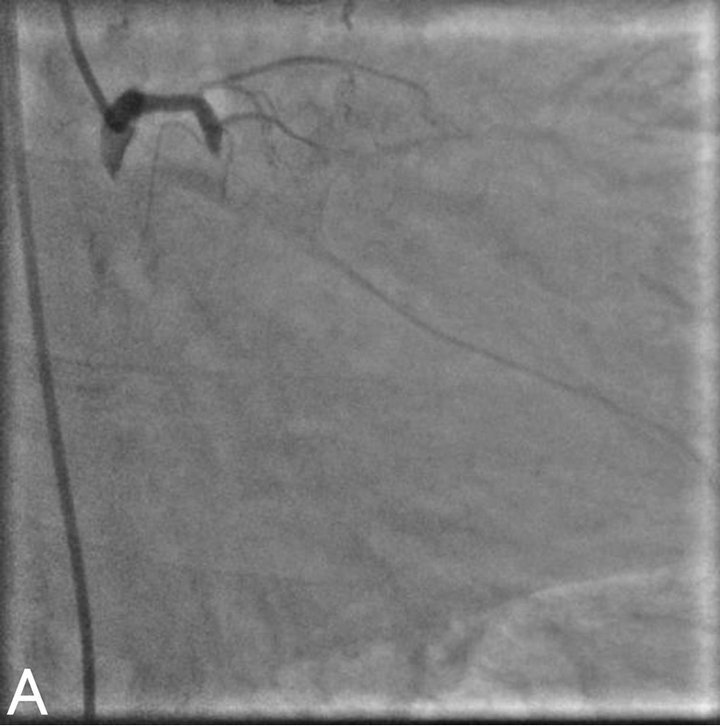

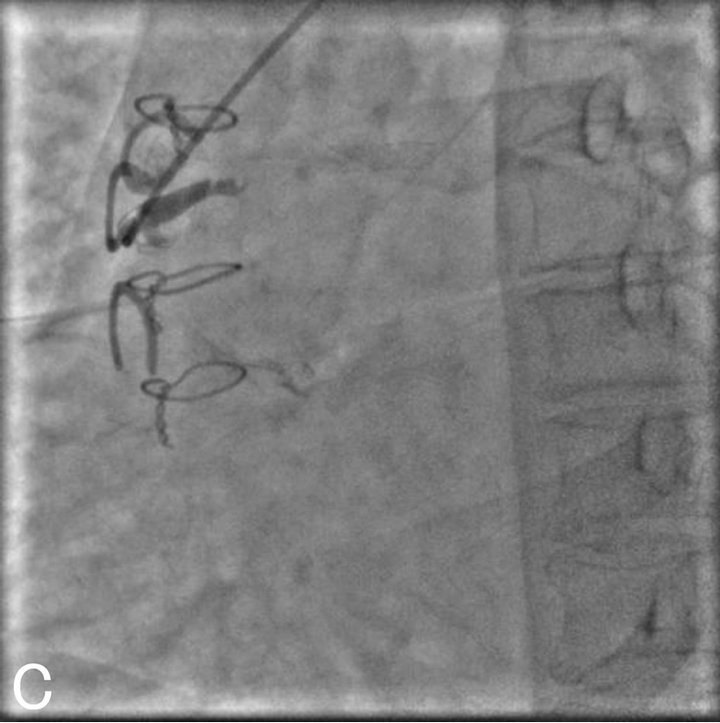
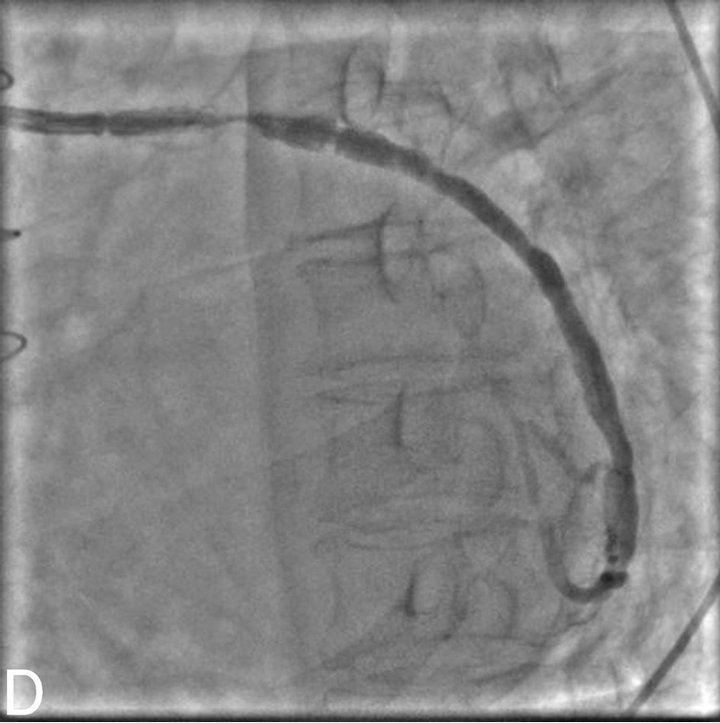
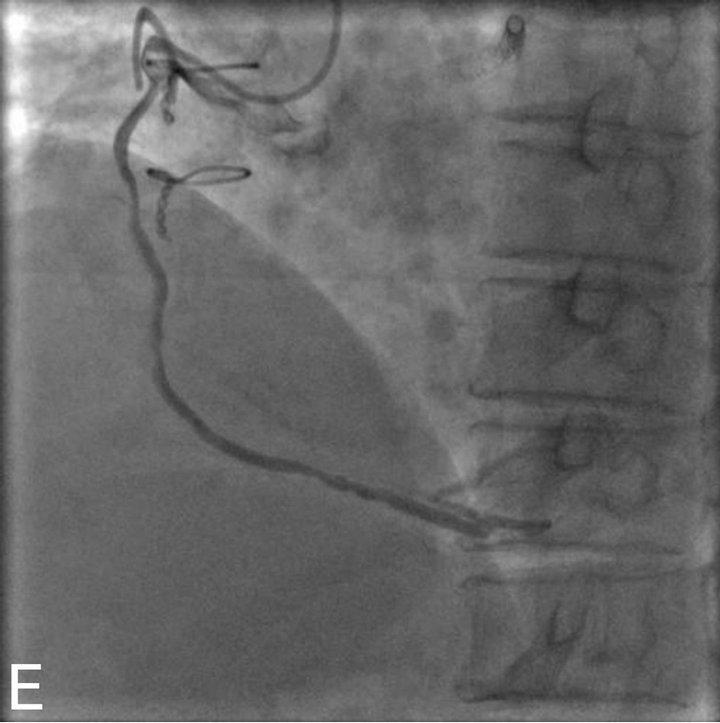
Figure 1. Emergent coronary angiography showing total occlusion at (A) the ostium of the left anterior descending artery (LAD), the proximal portion of the left circumflex artery (LCX), and (B) the proximal portion of the right coronary artery (RCA). (C) The saphenous vein graft (SVG)-LAD is also totally occluded at the proximal portion. (D) (E) The SVG-posterolateral (PL) and SVG-right posterior descending artery (RPDA) have several tight stenoses.

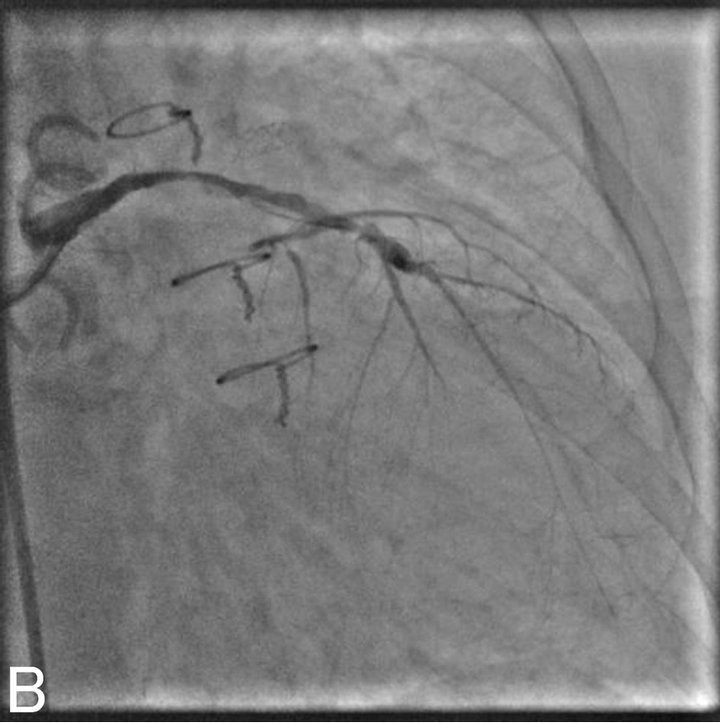
Figure 2. (A) Suboptimal flow with many thrombi after dilations in the saphenous vein graft (SVG)-left anterior descending artery (LAD); (B) Optimal flow after thrombectomy.
perform PCI for the native CTO lesion at the ostium of the LAD at a later date. Administration of aspirin, clopidogrel, and heparin were continued as antiplatelet and anticoagulation therapy after PCI.
The second PCI was undertaken four days after the first PCI. A 7 Fr Backup Left 3.5 guiding catheter with side holes (Heartrail II; Terumo Corp.) was inserted into the left coronary artery, and a 7 Fr AL 1.0 - 85 CM guiding catheter with side holes (Heartrail II; Terumo Corp.) was inserted into the SVG-LAD via the bi-femoral approach. At first, the antegrade approach was tried with an Ultimate Bross 3 guidewire (Asahi Intecc Co. Ltd.) and a Corsair microcatheter. However, the entry point of the CTO lesion was so hard that the guidewire could not be advanced into the CTO body. Next, a Confienza Pro guidewire (Asahi Intecc Co. Ltd.) was inserted into the sub-intimal space, and the retrograde approach was attempted. A Fielder FC guidewire (Asahi Intecc Co. Ltd.) with a long Corsair microcatheter (150 cm) was advanced into the SVG-LAD, which was critically degenerated. Careful manipulation successfully led the guidewire and Corsair to the distal site of the CTO lesion. The Ultimate Bross 3 guidewire failed to penetrate the distal entry point of the CTO lesion (Figure 3(A)). Therefore, another Confienza Pro was pushed into the CTO body in a retrograde manner. At this point, a reverse controlled antegrade and retrograde tracking (CART) technique was used, and a 2.5-mm diameter balloon was introduced into the CTO body in an antegrade manner. The balloon was inflated in the proximal part of the CTO lesion to create a large false lumen, which was connected to the true lumen of the left main coronary artery (LMCA). Following this balloon inflation, the retrograde guidewire was easily passed into the sub-intimal space to reach the true lumen of the LMCA. The retrograde guidewire was inserted into the antegrade guiding catheter lumen that was engaged in the left coronary artery (Figure 3(B)), following which the Corsair microcatheter was inserted in a retrograde manner into the antegrade guiding catheter. A 0.010 inch, 330 cm, RG3 guidewire (Asahi Intecc Co.
Ltd.) was inserted from the end of the retrograde Corsair to the antegrade guiding catheter to form a loop (retrograde wire externalization). Following predilation with a 2.5 mm diameter balloon, two sirolimus-eluting stents (Cypher select, 2.5 mm × 28 mm, Cordis, NJ, USA) were sequentially deployed in the LMCA and the proximal LAD from the antegrade end of the RG3 guidewire. Postdilation with a 3.5 mm diameter balloon was performed at the LMCA. The final angiogram showed successful revascularization of the LAD-CTO lesion (Figure 3(C)). Overall, this procedure was a success without any complication.
Subsequently, elective PCIs for the CTO lesions in the SVG-RCA and SVG-LCX were performed. The retrograde approach via the critically degenerated SVGs was performed in combination with the reverse CART technique to achieve successful revascularization of the RCA and LCX (Figure 4).
3. DISCUSSION
Despite the use of new interventional devices, PCI for SVG disease is still challenging because of high in-hospital mortality and the risk of Q-wave myocardial infarcttion. The risks associated with PCI for SVG disease have increased, especially with the treatment of aged SVGs because they contain more atheromatous plaque, foam cells, cholesterol crystals, blood elements, and necrotic debris. The long-term outcomes after PCI for SVG disease are also poor. In addition, once a degenerated SVG occludes totally or subtotally, the probability of recurrent events related or unrelated to the target lesion is high, even after successful revascularization [7].
Because of the unfavorable results of PCI for SVG disease, the procedure should be considered for the native coronary arteries in all possible cases. The outcome of PCI with drug-eluting stent placement in native coronary arteries has been established. In cases of CTO in a native artery, however, the procedural success rate of PCI is relatively low compared with that of PCI for nonoccluded lesions. Especially over a long course of CABG
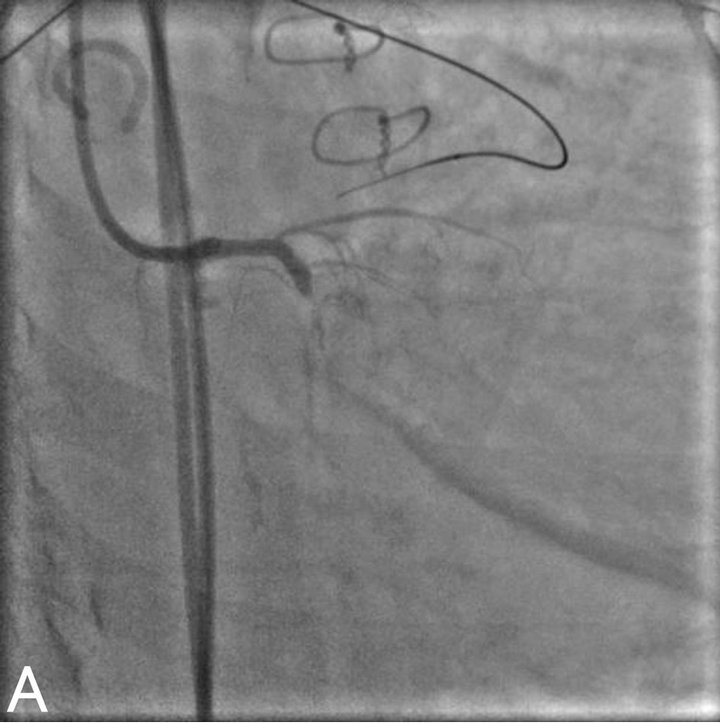
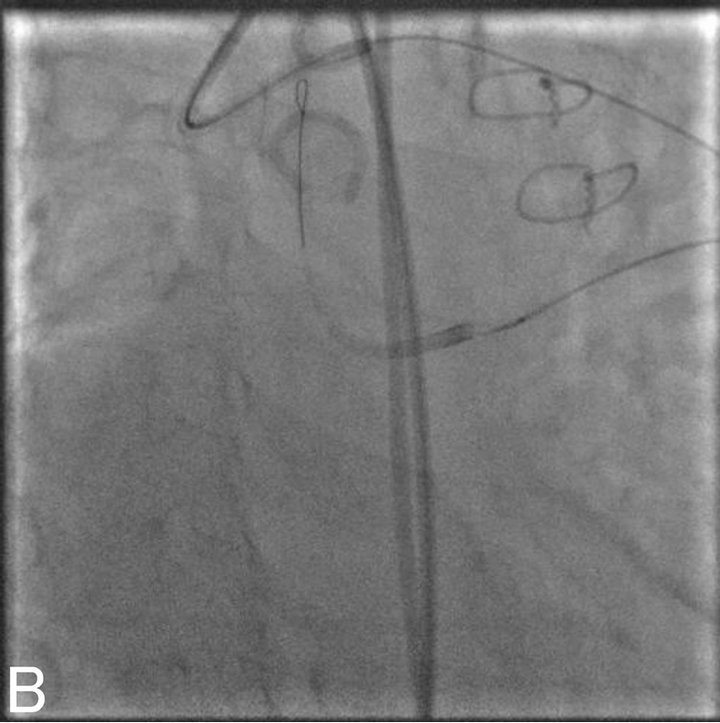

Figure 3. (A) A Confienza Pro guidewire with a Corsair microcatheter is advanced into the chronic total occlusion (CTO) body in a retrograde manner via the saphenous vein graft (SVG)-left anterior descending artery (LAD). (B) The retrograde guidewire is inserted into the antegrade guiding catheter lumen. (C) The final angiogram shows a successful revascularization in the left anterior descending artery.
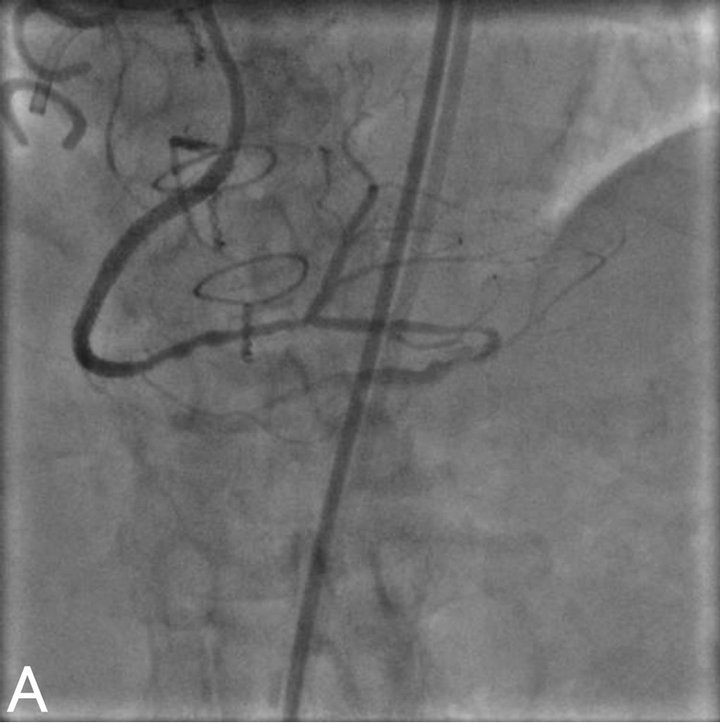

Figure 4. Final angiograms showing successful revascularizations in (A) the right coronary artery (RCA) and (B) the left circumflex artery (LCX).
surgery, the entry point and body of the CTO become so hard that treatment with the conventional approach becomes difficult. The retrograde approach is considered to be an effective alternative method for treating CTO. After development of the combination of the Corsair microcatheter and the CART technique, the advantages of the retrograde approach have become more obvious, and it has become a safe and reliable approach for PCI [5]. The Japanese multicenter registry reported that the success rate of only the antegrade approach for CTO lesions was 61.2% and the success rate of both antegrade and retrograde approach was 83.8% [8].
Here we reported a case of SVG disease with CTO in three native coronary arteries, in which successful complete revascularization was achieved using the retrograde approach via the critically degenerated SVGs. In the retrograde approach for cases without prior CABG, the septal channel and the epicardial channel are commonly used to connect to the target CTO lesion in a retrograde manner. However, this technique may be accompanied by several unexpected critical complications that do not occur during PCI using conventional techniques. These complications may be principally caused by injury and thrombus formation in the collateral-donor coronary artery. In the retrograde approach via critically degenerated SVGs, however, if a complication in the donor vessel occurs, it may not affect the unrelated coronary artery. Therefore, this technique is relatively safe. In the reverse CART technique using a Corsair microcatheter, it is not necessary to exchange the retrograde device once the Corsair microcatheter reaches the distal entry point of the CTO lesion via the degenerated SVG. Therefore, the possibility of a distal embolism due to the insertion and removal of the retrograde devices is relatively low. We suggest that PCI using the retrograde approach via critically degenerated SVGs is a reliable and safe method for CTO lesions.
On the other hand, the retrograde approach via critically degenerated SVGs offers a risk of complications. Distal embolism caused by manipulation of the guidewire and microcatheter in the degenerated SVG is an expected complication. Especially, in cases with an acute angle of the anastomosis between the SVG and the distal native coronary artery, there is powerful tension that can stretch the SVG and easily cause a distal embolism when the guidewire and microcatheter advance into the distal site of the CTO lesion.
In conclusion, we suggest that PCI using the retrograde approach via critically degenerated SVGs is a reliable and safe method for the treatment of CTO lesions. We used the retrograde approach via critically degenerated SVGs to successfully perform complete revascularization in a case of SVG disease with CTO in three native coronary arteries. We recommend the use of this technique while performing PCI for native CTO lesions.
REFERENCES
- Singh, M., Rihal, C.S., Lennon, R.J., Garratt, K.N., Mathew, V. and Holmes Jr., D.R. (2005) Prediction of complications of following nonemergency percutaneous coronary interventions. American Journal of Cardiology, 96, 907-912. doi:10.1016/j.amjcard.2005.05.045
- Surmely, J.F., Tsuchikane, E., Katoh, O., Nishida, Y., Nakayama, M., Nakamura, S., et al. (2006) New concept for CTO recanalization using controlled antegrade and retrograde subintimal tracking; the CART technique. Journal of Invasive Cardiology, 18, 334-338.
- Sianos, G., Barlis, P., Di Mario, C., Papafaklis, M.I., Buttner, J., Galassi, A.R., et al. (2008) European experience with the retrograde approach for the recanalization of coronary artery chronic total occlusion. A report on behalf of the EuroCTO club. Eurrointervention, 4, 84-92. doi:10.4244/EIJV4I1A15
- Muramatsu, T., Tsukahara, R. and Ito, Y. (2011) A novel intravascular ultrasound-guided percutaneous coronary angioplasty technique via the retrograde approach for chronic total occlusion. Cardiovascular Intervention and Therapeutics, 26, 45-51. doi:10.1007/s12928-010-0033-0
- Tsuchikane, E., Katoh, O., Kimura, M., Nasu, K., Kinoshita, Y. and Suzuki, T. (2010) The first clinical experience with a novel catheter for collateral channel tracking in retrograde approach for chronic coronary total occlusions. Journal of American College of Cardiology, Cardiovascular Intervention, 3, 165-171.
- Sekiguchi, M., Miyazima, A., Hasegawa, S., Yamazaki, M. and Kurabayashi, M. (2012) Retrograde percutaneous recanalization of chronic total occlusion of the left anterior descending artery through an extremely tortuous right ventricular branch. Cardiovascular Intervention and Therapeutics, 27, 210-213. doi:10.1007/s12928-012-0110-7
- Abdle-Karim, A.R., Banerjee, S. and Brilakis, E.S. (2010) Percutaneous intervention of acutely occluded saphenous vein grafts: Contemporary techniques and outcomes. Journal of Invasive Cardiology, 22, 253-257.
- Tsuchikane, E., Yamane, M., Mutoh, M., Matsubara, T., Fujita, T., Nakamura, S., Muramatsu, T., Okamura, A., Igarashi, Y. and Oida, A. (2013) Japanese multicenter registry evaluating the retrogradeapproach for chronic coronary total occlusion. Catheterization and Cardiovascular Interventions, Article ID: 24823. doi:10.1002/ccd.24823

